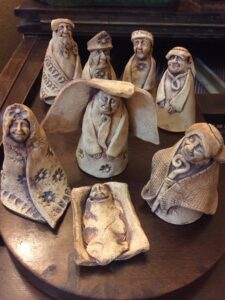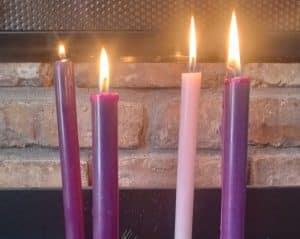Each year I look forward to the ritual of setting out various handmade nativity sets. The story is a universal one, that of bringing the life of God into the world. I have found depictions of various expressions of this story in different cultures, religions and peoples around the world. A miraculous conception and birth, signs of the coming divine presence, humble witnesses, wise seekers, the bringing of good news. Like countless people now and throughout time, I hunger for such a story.
The nativities that contribute to my yearly ritual show the hand of their maker. The unique expressions, ethnic features, animals native to far off lands, even fingerprint impressions left in clay figures – all speak of a person who pictured themselves in this story, this experience of being a part of bringing God into the world. In the ritual, I consider the role of each person or creature, and how it contributed to the story. Then I consider how I might be doing something in that way now that would presence the life of God now.
This year, I am thinking of an expanded story, and parts of it that are not depicted in most Nativity sets.
Last March, Mike and I were in Israel. We had a rich experience there, much of that was due to the local guides who helped us learn many aspects of the cultural and spiritual history.
When we spent a day in Bethlehem, our guide was a Catholic woman whose ancestral connection to the town went back for many centuries. After visiting the traditional site of the Nativity, she took us to a nearby site that is considered to be that of the Inn where the couple was turned away. She shared a perspective I had never considered. She said that Mary and Joseph would have come to Bethlehem expecting to stay with family. Custom dictated that family would have accommodated them. But there is local lore that says the relatives of Mary and Joseph who owned the Inn, or hospitality house, did not approve of this marriage of Joseph to a woman who was already pregnant. It wasn’t so much there was no room in the Inn, it was that there was no room in their hearts for anyone who did not meet their standards of propriety. Our guide shared insight, saying that even though these family members did not make room for God to come into the world because of their disapproval – God still came into the world. The family members are the ones who missed out. Our guide asked us to have room in our hearts and minds for God to be born and live among us, even and especially in ways we would never expect, for God will come somehow. We can either choose to be a part of it, or miss out on it because we have no room.
She asked us to not turn away those who have been condemned by society, or tradition. This is how God comes to the world.
Now, as I set out another Mary figure, I think of God as anyone whose existence is denied, whose life is at risk, because so many in power shut the door to their voice, their bodies, their presence – and I think of how salvation comes to the world each time room is made for them.
I only have one nativity set that includes a figure of Elizabeth. She is there, carrying her baby John on her back. I often think of this part of the story. Mary hungered to see, to be with a wise woman at this time of entering the unknown. I picture Elizabeth hurrying to greet her, and somehow recognizing the sudden motion of recognition in the life within her. Then her joyful crying out the good news, “There is life in me that sees God is in the world, and God is in you.”
I think we each have life within us that is able to recognize and create God in each other. I think we can help that life grow, and continue to witness the many ways people contribute to the presence of God in the world.
For me, the wonder and transformative power of the story of God being born into the world is not only that it happened long ago – but that we, like so many then, can be a part of making it happen now.
There is life within me that leaps with joy when I see God in others.
My Nativity ritual now calls me to practice this always.








